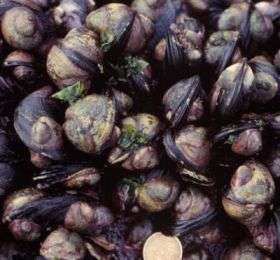Sea snails break the law

Lizards gave rise to legless snakes. Cave fishes don’t have eyeballs. In evolution, complicated structures often get lost. Dollo’s Law states that complicated structures can't be re-evolved because the genes that code for them were lost or have mutated. A group of sea snails breaks Dollo’s law, Rachel Collin, Staff Scientist at the Smithsonian Tropical Research Institute and colleagues from two Chilean universities announce in the April, 2007, Biological Bulletin.
"This is important because it shows that animals may carry the potential for evolutionary change around with them. When the environment changes, new life forms may be able to regain abilities that were lost earlier in evolutionary history," Collin explains.
Most species of sea snail go through several life stages on the way to becoming reproductive adults. The early stages, or larvae, usually live in the water column eating microscopic algae and swimming with a specialized structure called the velum. This stage has been lost in many species, where development happens in immobile capsules protected by the mother. In these species, small bottom-dwelling juvenile snails (miniature adults) hatch out of eggs and crawl away. Thus, a whole life stage, the motile larva, is lost and thought to never been re-gained.
But how can you tell what happened in the past to bring this about? Collaborators from Chile, Argentina and the Smithsonian in Panama, using embryological observations and DNA sequencing, show that the larval stage can be reacquired.
The group collected 6 species of the genus Crepipatella from the shorelines of Argentina, Chile, Panama, Peru, South Africa and the United States. They observed the developmental stages of each species and sequenced a gene called mitochondrial cytochrome oxidase I. Then, based on the differences in gene sequences, they used several different techniques to reconstruct family trees.
Indeed, they found that motile, feeding larvae had been lost and re-gained in the same family group, which breaks Dollo’s law. Collin sums this up: "The embryos of limpets in a group called Crepipatella seem to retain some of the apparatus they would need for larval feeding and swimming, even though they do not produce larvae. Then, from DNA data we see that one species with larvae has re-evolved in the middle of a group that doesn't have them. It does go both ways! There’s more flexibility in animal evolution than people thought."
Source: Smithsonian Tropical Research Institute

















